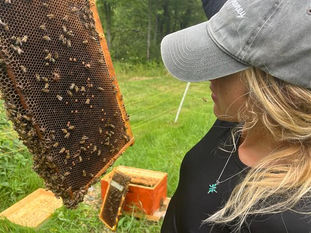Genevieve Benson NiCheallachain

My Hives didn't make it: Why Are Honey Bees Dying? (My Updates)
0
27
0
If you’ve heard that bees are in trouble — it’s true. The honey bee population continues to face serious challenges, even in 2024.

The biggest threats:
Pesticides (especially neonicotinoids, which impair memory and movement)
Habitat loss (less wild space = fewer flowers)
Parasites like the Varroa mite (tiny, deadly hitchhikers that weaken entire colonies)
Climate change (messes with bloom timing and nectar flow)
Even small stressors can compound into colony collapse. But the good news? Backyard beekeepers, native pollinator advocates, and wildflower planters are stepping up in a big way. Look, you can help — plant pollinator-friendly flowers, reduce pesticide use, and support local beekeepers.
🌡️ 1. Extreme Weather Swings
Climate change is bringing more unpredictable seasons — with warm spells in mid-winter, sudden freezes in early spring, and droughts through summer. These swings confuse bees, disrupt their foraging cycles, and kill off early food sources like wildflowers and tree blossoms.
Bees need rhythm. Nature’s offbeat patterns are throwing off their survival cues.
🦠 2. Persistent Parasites (Varroa Destructor)
The Varroa mite continues to be one of the most destructive forces in modern beekeeping. These tiny, tick-like parasites weaken bees by feeding on them and spreading viruses — and many colonies entered 2024 already heavily infested from the prior year.
Treatments exist, but they’re not always 100% effective — especially when hives are already stressed.
🌼 3. Lack of Floral Diversity
Urban sprawl, monoculture farming, and well-manicured (but flowerless) yards mean bees are struggling to find consistent, diverse nutrition. When bees eat from the same source over and over (like fields of almonds or canola), they miss out on the full range of nutrients they need.
Imagine living off only one food forever — even if it’s technically “healthy,” you’d feel it.
💨 4. Pesticide Drift
Even if a beekeeper doesn’t use chemicals near their hives, nearby farms or landscaping companies might. Insecticides, herbicides, and fungicides can all affect bee health — especially neonicotinoids, which remain in soil and water for years and impair memory, movement, and navigation.
😔 5. Queen Failure
Many hives that didn’t survive showed signs of queen failure — where the queen either stopped laying eggs or wasn’t laying viable brood. This could be due to poor genetics, age, stress, or even pesticide exposure.
Without a strong queen, a hive simply can’t sustain itself.
🤝 6. Stress from Constant Human Intervention
Even well-meaning beekeepers can cause stress by over-inspecting, moving hives frequently, or harvesting too much honey. Combined with all of the above, it adds to a hive’s burden.
🧠 The Takeaway:
Bee loss in 2024 wasn’t just one thing — it was everything, all at once. The climate, the chemicals, the pests, the shrinking food supply.
But it’s also a call to act.
We can still support bees — by planting pollinator gardens, avoiding chemical sprays, supporting small-scale ethical beekeepers, and staying educated and gentle in our interventions.
Bee health is ecosystem health. And ecosystem health is our health.





